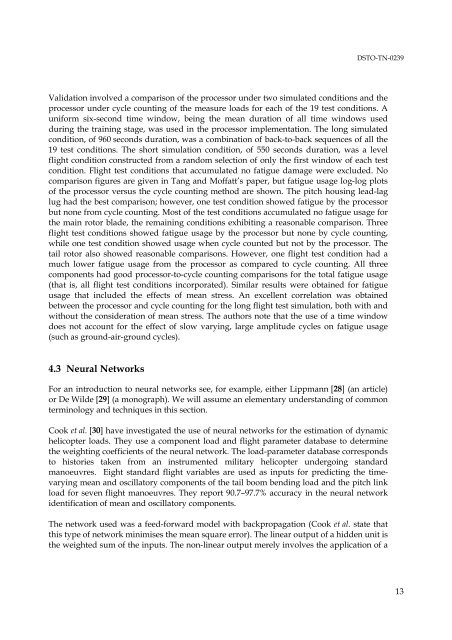Estimation of Structural Component Loads in Helicopters: A Review ...
Estimation of Structural Component Loads in Helicopters: A Review ...
Estimation of Structural Component Loads in Helicopters: A Review ...
Create successful ePaper yourself
Turn your PDF publications into a flip-book with our unique Google optimized e-Paper software.
DSTO-TN-0239Validation <strong>in</strong>volved a comparison <strong>of</strong> the processor under two simulated conditions and theprocessor under cycle count<strong>in</strong>g <strong>of</strong> the measure loads for each <strong>of</strong> the 19 test conditions. Auniform six-second time w<strong>in</strong>dow, be<strong>in</strong>g the mean duration <strong>of</strong> all time w<strong>in</strong>dows useddur<strong>in</strong>g the tra<strong>in</strong><strong>in</strong>g stage, was used <strong>in</strong> the processor implementation. The long simulatedcondition, <strong>of</strong> 960 seconds duration, was a comb<strong>in</strong>ation <strong>of</strong> back-to-back sequences <strong>of</strong> all the19 test conditions. The short simulation condition, <strong>of</strong> 550 seconds duration, was a levelflight condition constructed from a random selection <strong>of</strong> only the first w<strong>in</strong>dow <strong>of</strong> each testcondition. Flight test conditions that accumulated no fatigue damage were excluded. Nocomparison figures are given <strong>in</strong> Tang and M<strong>of</strong>fatt’s paper, but fatigue usage log-log plots<strong>of</strong> the processor versus the cycle count<strong>in</strong>g method are shown. The pitch hous<strong>in</strong>g lead-laglug had the best comparison; however, one test condition showed fatigue by the processorbut none from cycle count<strong>in</strong>g. Most <strong>of</strong> the test conditions accumulated no fatigue usage forthe ma<strong>in</strong> rotor blade, the rema<strong>in</strong><strong>in</strong>g conditions exhibit<strong>in</strong>g a reasonable comparison. Threeflight test conditions showed fatigue usage by the processor but none by cycle count<strong>in</strong>g,while one test condition showed usage when cycle counted but not by the processor. Thetail rotor also showed reasonable comparisons. However, one flight test condition had amuch lower fatigue usage from the processor as compared to cycle count<strong>in</strong>g. All threecomponents had good processor-to-cycle count<strong>in</strong>g comparisons for the total fatigue usage(that is, all flight test conditions <strong>in</strong>corporated). Similar results were obta<strong>in</strong>ed for fatigueusage that <strong>in</strong>cluded the effects <strong>of</strong> mean stress. An excellent correlation was obta<strong>in</strong>edbetween the processor and cycle count<strong>in</strong>g for the long flight test simulation, both with andwithout the consideration <strong>of</strong> mean stress. The authors note that the use <strong>of</strong> a time w<strong>in</strong>dowdoes not account for the effect <strong>of</strong> slow vary<strong>in</strong>g, large amplitude cycles on fatigue usage(such as ground-air-ground cycles).4.3 Neural NetworksFor an <strong>in</strong>troduction to neural networks see, for example, either Lippmann [28] (an article)or De Wilde [29] (a monograph). We will assume an elementary understand<strong>in</strong>g <strong>of</strong> commonterm<strong>in</strong>ology and techniques <strong>in</strong> this section.Cook et al. [30] have <strong>in</strong>vestigated the use <strong>of</strong> neural networks for the estimation <strong>of</strong> dynamichelicopter loads. They use a component load and flight parameter database to determ<strong>in</strong>ethe weight<strong>in</strong>g coefficients <strong>of</strong> the neural network. The load-parameter database correspondsto histories taken from an <strong>in</strong>strumented military helicopter undergo<strong>in</strong>g standardmanoeuvres. Eight standard flight variables are used as <strong>in</strong>puts for predict<strong>in</strong>g the timevary<strong>in</strong>gmean and oscillatory components <strong>of</strong> the tail boom bend<strong>in</strong>g load and the pitch l<strong>in</strong>kload for seven flight manoeuvres. They report 90.7–97.7% accuracy <strong>in</strong> the neural networkidentification <strong>of</strong> mean and oscillatory components.The network used was a feed-forward model with backpropagation (Cook et al. state thatthis type <strong>of</strong> network m<strong>in</strong>imises the mean square error). The l<strong>in</strong>ear output <strong>of</strong> a hidden unit isthe weighted sum <strong>of</strong> the <strong>in</strong>puts. The non-l<strong>in</strong>ear output merely <strong>in</strong>volves the application <strong>of</strong> a13
















